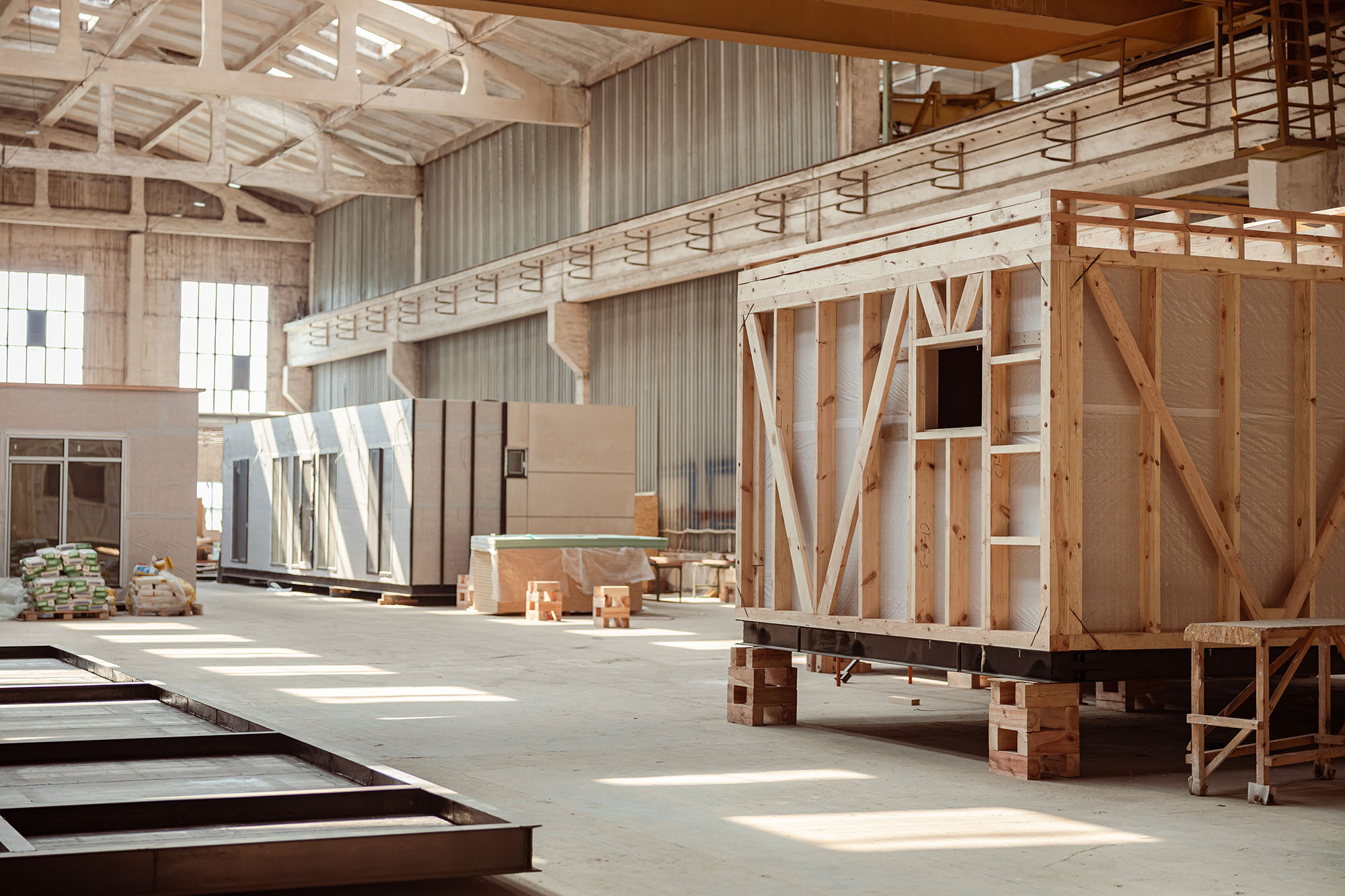The UK was leading the way in Modern Methods of Construction. But, as the offsite construction industry within private housing faces up to its challenges, Andrew Crudgington asks if other sectors could benefit from the concept.
The construction industry is not immune to hype or just plain old wishful thinking. This doesn’t always end well, so anyone looking to cut through the noise and find some hard, evidence based analysis of what is happening in our industry could do a lot worse than follow the LinkedIn feed of Noble Francis, Economics Director at the Construction Products Association.
So when Legal & General halted production at its modular housing factory near Leeds in May, followed quickly by modular housebuilder Ilke Homes going into administration I was keen to see what Noble had to say. His analysis was suitably sharp, and worth quoting at length:
The top 10 UK house builders employ 1 person across all areas for every 3 homes they build, which (for better or worse) does not make for the most efficient, cost effective or error-free building, but these business models based on subcontracting out cost, activity and risk (as opposed to high investment upfront in fixed, inflexible assets from offsite manufacturing that continually make losses) does make major house builders resilient and illustrates why none of the major house builders went out of business in the financial crisis despite private housing starts falling 71% peak to trough.
I recognise that it would be misleading to suggest that everything is looking gloomy for offsite house-building. It continues to receive a lot of support in government policy and there is still enthusiasm in the market. As an example Goldman Sachs backed TopHat recently successfully raised £70m in its latest funding round. It does however seem increasingly unlikely that the UK is going to rapidly follow the path of Scandinavia where circa 45% of new houses involve some form of Modern Method of Construction (MMC).
All of this nags away at something that has been bothering me for a number of years – it seems to me that too often efforts to deploy potential solutions to UK construction’s endemic problems with productivity, quality and safety end up being effective at highlighting our underlying structural issues of fragmentation, low productivity and low skills.
Another, more positive way of describing my concern, is that perhaps our efforts to use these solutions are being focused in the wrong places. As Noble’s quote suggests, private sector house building is extremely cyclical, creating real problems for factory production with its high upfront cost and reliance on a stable pipeline of work.
As last week’s report from Parliament’s Levelling-Up, Housing and Communities Committee makes clear, government currently lacks the will – or to be a little fairer – political room for manoeuvre – to do a great deal to help create these pipelines via housebuilding targets. Initiatives like the commissioning of BSI to create a new standard for homes built using Modern Methods of Construction (MMC) should help reduce upfront costs, and by boosting interoperability help manufacturers diversify their client base. The time has perhaps however come to accept that offsite manufacturing in commercial housebuilding faces too many headwinds to really grow at the scale that will make it much more than a small to medium sized contributor to meeting our needs.
So where might we look to really exploit the potential of doing things differently?
Analysis by the Construction Innovation Hub discussed in a BBA podcast earlier this year has found that circa 70% of the UK’s £50B+ pipeline of social and economic infrastructure could be addressed is some way by Product Platform Approaches.
In that same podcast, BBA Technical Director Bill Hewlett argued that it is a mistake to think of Platforms as just synonym for offsite and/or, modular construction. In Bill’s view they are really a whole different way of thinking about how construction is done, whose key elements include a common component set, a definition of standard interfaces and much greater integration between the traditional supply chain and manufacturers. This system is then oiled by interoperable data flowing through and drawing together their systems.
Executing this kind of approach needs a client who can aggregate and standardise demand over long term pipelines of work The demand for economic and social infrastructure activity can of course also be volatile, as recent reprofiling of HS2 and major road schemes exemplify. However, demand is steadier than in commercial housebuilding, and in sectors such as water, the UK has needs for construction work that are as close to unavoidable as can be imagined, all underpinned by a well-established, independently regulated investment cycle. Similarly, flagship public sector programmes to build schools, hospitals and prisons, are in a strong position to move away from specifying their needs on a project by project basis, and by doing so help stimulate deeper product markets and greater industry capacity to deliver new approaches to construction.
None of this is to suggest that MMC has no future in housebuilding. The potential benefits for cost, carbon and quality are too great to be abandoned. Government and industry do need to continue to work together to overcome barriers to its use in the sector, including weak policy around housebuilding targets and a lack of harmonised standards. If, however, we want to drive a more systematic change to how construction is done in the UK, in which MMC is just one part of a more radical information, social and economic infrastructure may be a better place to start.

AUTHOR PROFILE:
Andrew Crudgington is an independent researcher and writer who works across the built environment. Previously he was Director of Policy at the Institution of Civil Engineers.
Share This Story, Choose Your Platform!
Related News
The UK was leading the way in Modern Methods of Construction. But, as the offsite construction industry within private housing faces up to its challenges, Andrew Crudgington asks if other sectors could benefit from the concept.
The construction industry is not immune to hype or just plain old wishful thinking. This doesn’t always end well, so anyone looking to cut through the noise and find some hard, evidence based analysis of what is happening in our industry could do a lot worse than follow the LinkedIn feed of Noble Francis, Economics Director at the Construction Products Association.
So when Legal & General halted production at its modular housing factory near Leeds in May, followed quickly by modular housebuilder Ilke Homes going into administration I was keen to see what Noble had to say. His analysis was suitably sharp, and worth quoting at length:
The top 10 UK house builders employ 1 person across all areas for every 3 homes they build, which (for better or worse) does not make for the most efficient, cost effective or error-free building, but these business models based on subcontracting out cost, activity and risk (as opposed to high investment upfront in fixed, inflexible assets from offsite manufacturing that continually make losses) does make major house builders resilient and illustrates why none of the major house builders went out of business in the financial crisis despite private housing starts falling 71% peak to trough.
I recognise that it would be misleading to suggest that everything is looking gloomy for offsite house-building. It continues to receive a lot of support in government policy and there is still enthusiasm in the market. As an example Goldman Sachs backed TopHat recently successfully raised £70m in its latest funding round. It does however seem increasingly unlikely that the UK is going to rapidly follow the path of Scandinavia where circa 45% of new houses involve some form of Modern Method of Construction (MMC).
All of this nags away at something that has been bothering me for a number of years – it seems to me that too often efforts to deploy potential solutions to UK construction’s endemic problems with productivity, quality and safety end up being effective at highlighting our underlying structural issues of fragmentation, low productivity and low skills.
Another, more positive way of describing my concern, is that perhaps our efforts to use these solutions are being focused in the wrong places. As Noble’s quote suggests, private sector house building is extremely cyclical, creating real problems for factory production with its high upfront cost and reliance on a stable pipeline of work.
As last week’s report from Parliament’s Levelling-Up, Housing and Communities Committee makes clear, government currently lacks the will – or to be a little fairer – political room for manoeuvre – to do a great deal to help create these pipelines via housebuilding targets. Initiatives like the commissioning of BSI to create a new standard for homes built using Modern Methods of Construction (MMC) should help reduce upfront costs, and by boosting interoperability help manufacturers diversify their client base. The time has perhaps however come to accept that offsite manufacturing in commercial housebuilding faces too many headwinds to really grow at the scale that will make it much more than a small to medium sized contributor to meeting our needs.
So where might we look to really exploit the potential of doing things differently?
Analysis by the Construction Innovation Hub discussed in a BBA podcast earlier this year has found that circa 70% of the UK’s £50B+ pipeline of social and economic infrastructure could be addressed is some way by Product Platform Approaches.
In that same podcast, BBA Technical Director Bill Hewlett argued that it is a mistake to think of Platforms as just synonym for offsite and/or, modular construction. In Bill’s view they are really a whole different way of thinking about how construction is done, whose key elements include a common component set, a definition of standard interfaces and much greater integration between the traditional supply chain and manufacturers. This system is then oiled by interoperable data flowing through and drawing together their systems.
Executing this kind of approach needs a client who can aggregate and standardise demand over long term pipelines of work The demand for economic and social infrastructure activity can of course also be volatile, as recent reprofiling of HS2 and major road schemes exemplify. However, demand is steadier than in commercial housebuilding, and in sectors such as water, the UK has needs for construction work that are as close to unavoidable as can be imagined, all underpinned by a well-established, independently regulated investment cycle. Similarly, flagship public sector programmes to build schools, hospitals and prisons, are in a strong position to move away from specifying their needs on a project by project basis, and by doing so help stimulate deeper product markets and greater industry capacity to deliver new approaches to construction.
None of this is to suggest that MMC has no future in housebuilding. The potential benefits for cost, carbon and quality are too great to be abandoned. Government and industry do need to continue to work together to overcome barriers to its use in the sector, including weak policy around housebuilding targets and a lack of harmonised standards. If, however, we want to drive a more systematic change to how construction is done in the UK, in which MMC is just one part of a more radical information, social and economic infrastructure may be a better place to start.

AUTHOR PROFILE:
Andrew Crudgington is an independent researcher and writer who works across the built environment. Previously he was Director of Policy at the Institution of Civil Engineers.
Share This Story, Choose Your Platform!
Related News
Get in touch
Please complete the form below and we will contact you as soon as possible.
To help us to respond to your inquiry as quickly as possible, we have put a handy list of our services below.


